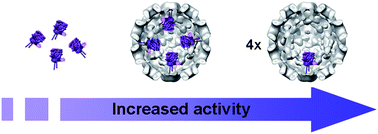Confining enzymes in a small container increases overall reaction rates but the increase is independent of the number of enzymes encapsulated, claim scientists in the Netherlands.
Jeroen Cornelissen, at the University of Twente, and colleagues used the capsid of the Cowpea Chlorotic Mottle virus to encapsulate enzymes, mimicking the crowded environment enzymes experience in a cell. They found that encapsulated enzymes have a higher activity than free enzymes, which they say is caused by the high confinement molarity of the enzyme and the increased collision rate with its substrate.
- Encapsulation of enzymes in the confined space of a virus capsid influences reaction rates
But increasing the number of enzymes inside the capsid does not increase the reaction rate, says Cornelissen. A capsid rarely contains more than one substrate molecule so one enzyme is sufficient to convert the substrate, he explains.
Want to learn more about the art of confinement? Read the Edge article for free online.
Do you feel confined by the page and colour restrictions placed on you by other journals? Experience the freedom of publishing with Chemical Science by submitting today.











